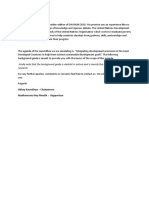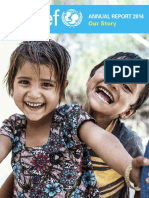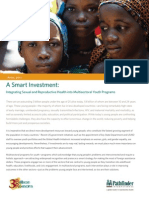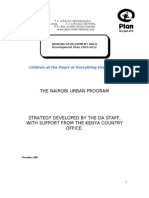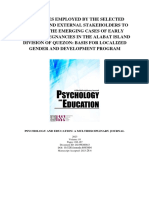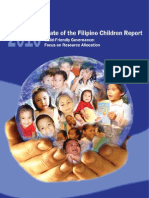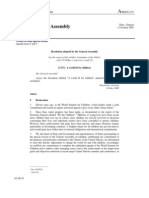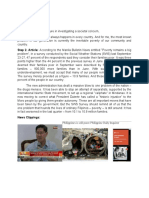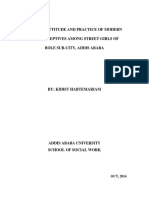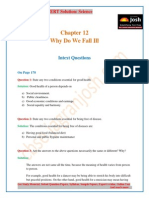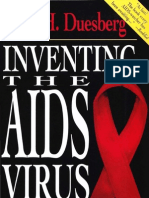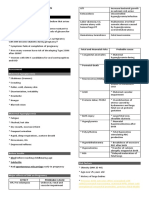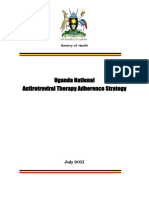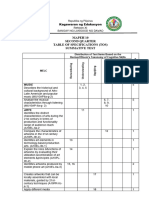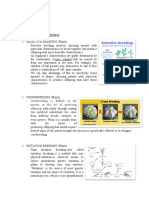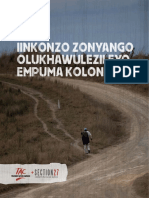0 ratings0% found this document useful (0 votes)
35 viewsSituation Review of Children in ASEAN: For Every Child Health, Education, Equality, Protection Advance Humanity
Situation Review of Children in ASEAN: For Every Child Health, Education, Equality, Protection Advance Humanity
Uploaded by
Sofia Ann Santos18 years ago, world leaders created a global treaty to recognize the rights of children everywhere. For children in South-East Asia the commitments outlined in the CRC are starting to bear fruit. Significant progress on the reduction of child mortality, increases in school enrolment, better laws to protect children.
Copyright:
© All Rights Reserved
Available Formats
Download as PDF, TXT or read online from Scribd
Situation Review of Children in ASEAN: For Every Child Health, Education, Equality, Protection Advance Humanity
Situation Review of Children in ASEAN: For Every Child Health, Education, Equality, Protection Advance Humanity
Uploaded by
Sofia Ann Santos0 ratings0% found this document useful (0 votes)
35 views32 pages18 years ago, world leaders created a global treaty to recognize the rights of children everywhere. For children in South-East Asia the commitments outlined in the CRC are starting to bear fruit. Significant progress on the reduction of child mortality, increases in school enrolment, better laws to protect children.
Original Title
Asean Book
Copyright
© © All Rights Reserved
Available Formats
PDF, TXT or read online from Scribd
Share this document
Did you find this document useful?
Is this content inappropriate?
18 years ago, world leaders created a global treaty to recognize the rights of children everywhere. For children in South-East Asia the commitments outlined in the CRC are starting to bear fruit. Significant progress on the reduction of child mortality, increases in school enrolment, better laws to protect children.
Copyright:
© All Rights Reserved
Available Formats
Download as PDF, TXT or read online from Scribd
Download as pdf or txt
0 ratings0% found this document useful (0 votes)
35 views32 pagesSituation Review of Children in ASEAN: For Every Child Health, Education, Equality, Protection Advance Humanity
Situation Review of Children in ASEAN: For Every Child Health, Education, Equality, Protection Advance Humanity
Uploaded by
Sofia Ann Santos18 years ago, world leaders created a global treaty to recognize the rights of children everywhere. For children in South-East Asia the commitments outlined in the CRC are starting to bear fruit. Significant progress on the reduction of child mortality, increases in school enrolment, better laws to protect children.
Copyright:
© All Rights Reserved
Available Formats
Download as PDF, TXT or read online from Scribd
Download as pdf or txt
You are on page 1of 32
Situation Review of Children in ASEAN
For every child
Health, Education, Equality, Protection
ADVANCE HUMANITY
For every child
Health, Education, Equality, Protection
ADVANCE HUMANITY
Situation Review of Children in ASEAN
A report by UNICEF to the Association of Southeast Asian Nations
December 2007
Cover photographs courtesy of UNICEF, East Asia and Pacific Regional Office
UNICEF, East Asia and Pacific Regional Office, 2007
Any part of this publication may be freely reproduced with the appropriate acknowledgement.
Design and layout: Keen Media (Thailand) Co., Ltd.
Printed in Thailand
UNICEF East Asia Pacific Regional Office
19 Phra Atit Road
Bangkok 10200 Thailand
Tel: (66 2) 356 9400
Fax: (66 2) 280 3563
E-mail: eapro@unicef.org
Website: www.unicef.org/eapro
ISBN: 978-974-685-089-6
FOREWORD
This year marks an important milestone in the lives of our children. Eighteen years ago, world
leaders created a global treaty to recognize the rights of children everywhere. Today, 18 years on,
there is an entire generation of children who have grown up under the protection of the United
Nations Convention on the Rights of the Child (CRC). For children in South-East Asia the commitments
outlined in the CRC are starting to bear fruit. Progress to guarantee every childs right to survival,
development, protection and participation has been made.
All 10 Member States of the Association of Southeast Asian Nations (ASEAN) have ratified the CRC,
and have started to align national laws, build stronger legal frameworks for children and establish
and strengthen national institutions that deal with childrens issues. Significant progress on the
reduction of child mortality, increases in school enrolment, better laws to protect children and the
improvement in childrens overall well being has been achieved.
Yet great challenges remain. In spite of sustained economic growth in the region that has contributed
to lifting many people out of poverty, not everyone is benefiting. For many children whether they
are ethnic minorities, children of migrant workers, children living in underserved rural communities,
or those crowded in urban shanty towns the provision of quality social services and their protection
from exploitation and violence is still a distant reality. Emerging diseases like Avian Influenza (AI),
the further spread of HIV and AIDS, and ongoing environmental disasters also threaten development
achievements and pose great risk to children.
This document provides an overview of the situation of children in South-East Asia. Divided into
chapters focused on each of the key critical components to meeting our child rights obligations, it
seeks to review the situation, highlight where progress has been made and illustrate what types of
action can be taken to further accelerate results.
Along with the CRC, leaders from South-East Asia have committed themselves to achieving the
global international development goals laid out in the United Nations Millennium Development
Goals (MDGs) and UNICEFs World Fit for Children. ASEANs Commitments for Children (2001), the
series of Declaration on Co-operation in Youth Development and the Cebu Declaration on One Caring
and Sharing Community (2007) underscore the regions further commitment to meeting these
development goals and promoting equity.
As a longstanding development partner to countries in South-East Asia, UNICEF remains committed
to working with governments to provide the leadership, technical skills and guidance needed. In
addition to the ongoing work within countries, UNICEF and ASEAN collaboration during the regional
Ministerial Consultations on Children, held biennially since 1991, has provided an important forum
to address a wide range of childrens issues.
To make the CRC a reality for every child requires more than just political commitment. We need to
ensure the right policies and laws are in place, that they are enforced and operational, and the
required resources are available to ensure every childs rights are met.
3
CONTENTS
FOREWORD 3
INTRODUCTION 7
CHILD SURVIVAL 10
Nutrition 12
Water, sanitation and hygiene 13
Preventing mother-to-child transmission of HIV 14
CHILD DEVELOPMENT 16
Early childhood education 16
Primary education 17
Secondary education 18
Adolescent development 19
CHILD PROTECTION 21
Violence against children 21
Trafficking, migration and exploitative child labour 23
Children deprived of their family environment 24
Children in conflict with the law 25
CHILD PARTICIPATION 26
CONCLUSION 27
INTRODUCTION
An estimated 197 million children under the age of 18 are living in the member states of ASEAN.
1
Today, these children are generally better off: healthier, more educated and safer than they ever
have been in the past. Over the last decade there has been a significant reduction in child mortality,
increase in school enrolment and improvement in the quality of life for the majority of the population.
Political stability, economic growth and social investments in development have all contributed to
these successes.
However, in common with global trends and combined with the regions enormous economic, social
and political diversity, progress is not even and pockets of exclusion remain. There are three broad
clusters of countries: those that have succeeded in meeting development goals and where, to a
large extent, the challenges of development have been overcome; those that are making good
progress and for which the goals for children are achievable by 2015; and those that still have a long
way to go before being able to declare victory.
However, for the region as a whole to enjoy stability and prosperity, it is important that more is done
to address disparities both between and within countries. This requires a concerted effort, especially
to reach the most marginalized and excluded people. For children the implications of disparity and
inequity can be severe, exacerbating the vulnerability of children to malnutrition, ill health, exclusion
from education, neglect and all forms of exploitation.
In this region, the poorest and most vulnerable people can belong to a number of groups. They may
confront geographical disparity, living in remote and under served areas; they may come from an
ethnic minority, such as migrant workers, refugees or displaced people; or they may be living with
disabilities or HIV and AIDS and may confront discrimination in access to services. Quite often little
is known about the situations of these groups.
The causes of disparity in the region are many and complex. Four key factors that can perpetuate
existing disparities or create new ones are rapid economic change due to globalization; unregulated
economic growth with low priority given to distribution; rapid decentralization that leaves local
governments without adequate resources and capacity to deliver services; and unregulated
privatization of key services health, education and water.
Already governments in this region have realized the importance of tackling these disparities and
have sought more inclusive and targeted approaches to reach those most in need. A critical step to
better addressing the problem must be the collection of disaggregated data on key social development
indicators. Better quantitative and qualitative data, and analysis with a focus on the poor and
most vulnerable are critical for informing policy-making processes and developing appropriate
programmes.
2
Along with better disaggregated data collection systems, is the need for more inclusive civil
registration systems. This region has made enormous strides in increasing the number of children
registered at birth. Birth registration is not only every childs right, it is also an important planning
tool that can help countries to understand what types of social investments will be needed to
meet the needs of their population. The challenge remains, especially as inter-regional mobility
increases, to ensure that both laws and services are available and inclusive to everyone.
In many countries, the good news is that child-friendly laws and policy frameworks are in place.
Most countries have ratified and adopted international laws and conventions that seek to protect
the rights of women and children. Much work has been done to revise national laws to confirm to
the CRC and other international conventions. The challenge of how to enforce these laws and
implement the policies so they can benefit everyone still remains.
1
The State of the Worlds Children 2007: Women and children, the double dividend of gender equality, UNICEF, New York, 2007.
2
With UNICEF support, many governments have already adopted a form of DevInfo, a software system that can help to centralize
data collection. Cambodia, CAMInfo; Indonesias MDG data is maintained in the UNICEF office, Lao PDR, ChildInfo; Myanmar,
Myinfo; the Philippines, ChildInfo; Thailand, Thai language DevInfo/TPD Info; and Viet Nam, ChildInfo/VietInfo.
7
8
One way to better guarantee public policy measures will work is to ensure adequate social sector
financing. Sadly, despite the high rates of economic growth, social spending has remained
inadequate. For example, the regions spending on public health services remains one of the lowest
in the world, while the out-of-pocket payments for medical services is one of the highest in the
world, often forcing already poor families into debt. On average the region spends only one third to
one half of what is invested in other middle- to low-income regions on health care, which is far
below the world average.
3
In addition to the potential for unrest and social tension caused by disparity, there are three cross-
cutting issues that, unless properly addressed, continue to pose threats to the regions development.
Migration
Globally, more and more people are moving in search of livelihoods and new opportunities.
South-East Asia is no exception as the region experiences movement of people both between
countries in the region and beyond to service demand in the Middle East, Europe and the United
States.
Safe, well-regulated migration that guarantees workers rights can bring enormous prosperity to
individual families as well as to communities and countries. Remittances have proved a very
important source of foreign investment.
Yet when not well-managed, migration can put workers, as well as their families, at great risk of
exploitation and abuse. For children, the dangers of being lured into a dangerous or exploitative
work environment or trafficked into child labour or the commercial sex industry are very real.
For children of migrant workers, the impact can be mixed. Evidence from the Philippines, along
with research from Indonesia and Thailand, suggests that, compared with non-migrants, the
children of migrants can benefit economically and often have access to better health care and
education back in their own communities. Remittances sent by parents who have migrated are
often an important source of income for the families left behind.
4
But there are also negative consequences for the children left behind. Deprived of parental
supervision and support they may develop social problems. In the Philippines, for example, the
children of migrant mothers reported feeling angry, lonely and afraid. For those that bring or
have children with them while abroad, the threat of their children being excluded from any
services and potentially being thrown out of the country is common. In Thailand, although migrant
children can access public schools, only 14 per cent (13,000) of the 93,000 registered migrant
children under the age of 15 enrolled in school due to the pressure to work.
5
The Challenge of HIV and AIDS
Overall in Asia, an estimated 4.9 million people were living with HIV in 2007, including the 440,000
people who became newly infected in the past year.
In Asia, national HIV prevalence is highest in South-East Asia, with a wide variation in epidemic
trends between different countries. While the epidemics in Cambodia, Myanmar and Thailand
all show declines in HIV prevalence, those in Indonesia (especially in the Papua province) and
Viet Nam are growing. Key drivers are use of contaminated injecting equipment, unprotected
paid sex and, to a lesser extent, unprotected sex between men.
3
A Region Where Every Child Counts. UNICEF EAPRO, Bangkok, 2005;
According to WHOs World Health Statistics on Health
Financing, OECD countries spend a larger share of their gross domestic product on health, spending on average more than 11%,
compared with 4.7% for countries in WHOs African and South-East Asian regions. This translates to per capita spending of about
US$ 3,170 in OECD countries compared with US$ 36 in countries in the African and South-East Asian regions, which are much
poorer. Linking this spending to epidemiology, the figure shows that although poorer WHO regions, such as Africa and South-East
Asia, account for the largest share of the global burden of disease (more than 50% of global disability-adjusted life years lost) and
37% of the worlds population, they spend about 2% of global resources on health. The Western Pacific Region, excluding
Australia, Japan, New Zealand and the Republic of Korea, accounts for 24% of the worlds population
(which is dominated by China), about 18% of the global burden of disease but only 2% of the worlds health resources.
4
The State of the Worlds Children 2007: Women and children, the double dividend of gender equality, UNICEF, New York, 2007, p.
47.
5
Ibid., para. 17.
ASEAN Situation Review of Children
9
Worldwide, the proportion of women living with HIV is still growing. In Asia, the proportion
reached 29 per cent in 2006. An estimated one third of people living with HIV in Viet Nam in 2006
were women. In Thailand, more than four in 10 (43 per cent) new infections in 2005 were among
women, the majority of whom probably acquired HIV from husbands or partners who had been
infected either during unsafe paid sex or injecting drug use.
6
Trends in the region also point to a growing incidence of HIV and AIDS among young people.
More children are either directly affected through infection or orphanhood or indirectly affected
as a result of increasing poverty of family members with the disease.
But there is hope. Some of the greatest successes in the global response to HIV and AIDS are in
this region. Thailand and Cambodia have managed to curb spiralling new HIV infections, and
Thailand also developed one of the most comprehensive sentinel and behavioural surveillance
systems in the world. Countries are becoming increasingly open and willing to share experiences,
and there are regional initiatives such as the Mekong Partnership and Beyond.
However, there is no room for complacency. The region must continue to focus on prevention
and awareness raising. To do this well, there needs to be better tools to track and reach high-risk
groups, address the stigma and marginalization that many of them suffer, as well as provide
comprehensive care, support and treatment services to those already infected.
Natural disasters, emerging diseases and conflict
South-East Asia is one of the most disaster prone areas of the world. Almost 75 per cent of all
deaths associated with natural disasters worldwide happen in Asia. Natural disasters ranging
from cyclones, typhoons, floods and landslides to earthquakes during the past year caused
loss of life, displacement, loss of livelihoods and destruction of property costing millions of
dollars. Regional, national and local emergency preparedness and early warning systems are
critical to be able to better respond.
This year Cambodia, Myanmar, Thailand, Malaysia, Singapore and Indonesia saw an increase in
dengue cases, approaching epidemic proportions and resulting in child deaths. Indonesia and
the Philippines are amongst the countries in the world most affected by natural disasters, with a
combined total of 20 incidents in 2006, causing more 9,000 deaths.
The highly pathogenic Avian Influenza (AI) continued to pose a serious threat, with outbreaks
continuing sporadically. Indonesia has been the most affected, confirming 107 cases and 86
deaths since 2003. Despite successful public education campaigns to alert people to the risk, the
challenge to reduce the potential spread of the infection and the continued concern that each
new human case will trigger a pandemic of a more highly transmissible virus remains very real.
The effects, especially on children in such an event would be catastrophic.
Unresolved political conflict affecting the security and welfare of children continues in the
Philippines and in Southern Thailand. In Myanmar, the situation continues to leave a large
number of families and children displaced, insecure and vulnerable.
Introduction
6
2007 AIDS Epidemic Update, UNAIDS & WHO, December 2007
10
7
Progress for Children, December 2007
8
The Millenium Development Goals Report 2007, United Nations
9
The State of the Worlds Children 2007: Women and children, the double dividend of gender equality, UNICEF, New York, 2007.
10
A Region Where Every Child Counts: Health, UNICEF EAPRO, Bangkok, 2005, p. 2.
11
Progress for Children, A Report Card on Nutrition: No. 4, UNICEF, New York, 2006, p. 20.
CHILD SURVIVAL
In 2006, for the first time, the global number of children dying before their fifth birthday fell below
10 million, to 9.7 million an important milestone in child survival. In 1960, an estimated 20 million
children under age five were dying every year, thus highlighting an important long-term milestone
in child deaths.
7
The fall in child deaths in South-East Asia has contributed significantly to this global achievement.
Between 1990 and 2006, the under-five mortality rate (U5MR) dropped from 78 to 41 per 1,000 live
births.
8
Increased access to health services, expanded immunization coverage, better management
of childhood illness, increased coverage of water and sanitation services, the introduction of
low-cost high-impact interventions and technology have all played important roles.
Although some countries in the region are on track to achieve MDG 4 to reduce child mortality and
MDG 5 to improve maternal health, significant challenges remain in guaranteeing that once the
goals are reached they then can be both sustained and expanded to eventually reach every child
and mother.
As of 2007, an estimated 54,792,000 under the age of five live in the member states of ASEAN.
9
Overall, the number of children dying before their fifth birthday has decreased in South-East Asia.
In 1999 an estimated 600,000 children died. The number decreased to 467,000 in 2006. The largest
gains reflected in this drop have been made in the Philippines, Viet Nam, Thailand and Malaysia,
where investments in primary health care including increases in vaccination coverage and
improved access to water and sanitation are starting to show results.
10
Singapore now has the lowest U5MR in the region lower than all industrialized countries except
Iceland. Progress is also being made in Lao PDR and Myanmar though still insufficently to meet
the MDG target.
11
Once U5MR drops to a range of 20 to 30 per 1,000 live births, non-communicable diseases, congenital
abnormalities, genetic disorders and unintentional child injuries become the leading killers, requiring
appropriate policies, better targeted interventions and increased budget allocations.
The greatest challenge to child survival remains the first year, often the first month of life, when the
majority of child deaths occur. Perinatal and neonatal mortality are strongly linked to conditions of
safe motherhood and delivery practices, as well as to maternal health and nutrition.
Reducing these deaths requires improving womens health during pregnancy, providing appropriate
care for both mothers and newborns during and immediately after birth, and caring for babies
during the first weeks of life. Cost-effective, feasible interventions include initiating breastfeeding
within one hour of birth, ensuring proper cord care, keeping the babies warm, recognizing danger
signs and seeking care, and giving special care to infants with low birth weights. A continuum of
care from pregnancy to early childhood should link community-based programmes to strengthened
health systems.
Child survival is inextricably linked to the health and well-being of the mother. Yet globally, maternal
mortality and malnutrition remain persistently high.
Malaysia, Thailand and Viet Nam are ahead of target to achieve MDG Goal 5 to reduce by three
quarters, between 1990 and 2015, the maternal mortality ratio. Despite progress in middle-income
countries in this region, many countries have rates that are stagnating as they appraoch the goal
and geographical disparities are growing.
11
12
Ibid., Table 8: Women, UNICEF, New York, 2007.
13
Ibid., p. 4.
Child survival
Across the region too many women still die unnecessarily every year as a result of complications
during pregnancy and childbirth. There is also enormous disparity among countries and regions
within countries in terms of access to skilled birth attendants, an important component of reducing
maternal mortality. For example, the adjusted maternal mortality ratio (MMR) of Malaysia is 62
while the adjusted MMR of Lao PDR is 660. In Malaysia 97 per cent of pregnant women have skilled
birth attendants, compared to 19 per cent of women in Lao PDR. Malaysias antenatal coverage is 74
per cent compared the coverage of Lao PDR, which is 27 per cent.
12
The challenges remain to reach all women with the needed antenatal and postnatal care to ensure
the safe delivery of the child and well-being of the mother.
In addition to geographical distance to health facilities, underlying much of the failure to achieve
more in maternal health stems from gender discrimination. For example the region has elevated-
levels of anaemia in women of child-bearing age and in pregnancy; low levels of secondary education
for girls; adolescent marriages and subsequent pregnancies in the more remote regions of various
countries; violence toward women in pregnancy; and inadequate birth spacing which all point to
a significant gender disparity in womens and girls access to nutrition, health facilities, education
and safety in the region.
13
Table 1: Neonatal, infant, maternal and under-five mortality rates, and maternal mortality ratio
Country Neo-natal Infant Under-five Under-five Maternal
mortality rate mortality rate mortality rate mortality rate mortality ratio
(deaths per (under one, (deaths per (rate of (deaths per
1,000 live deaths per 1,000 live progress 100,000 live
births) 1,000 live births) births) since 1990) births)
2000 2005 2005 Percentage 2005 (or latest
year available)
Brunei 4 8 9 18 37
Cambodia 40 66 83 -24 472
Indonesia 18 28 36 60 307
Lao PDR 35 70 98 52 660
Malaysia 5 6.7 9 45 62
Myanmar 40 74 105 19 316
Philippines 15 25 33 47 200
Singapore 1 3 3 67 30
Thailand 13 18 21 43 110
Viet Nam 15 16 19 64 150
Sources: Neonatal Mortality: The State of the Worlds Children 2007: Women and children, the double dividend of gender equality,
UNICEF, New York, 2007.
Infant Mortality: The State of the Worlds Children 2007: Women and children, the double dividend of gender equality,
UNICEF, New York, 2007; Cambodia Demographic and Health Survey 2005; Census 2005, Lao PDR National Statistic Center,
March 2006; Department of Statistics of Malaysia.
Under-five Mortality: The State of the Worlds Children 2007: Women and children, the double dividend of gender equality,
UNICEF, New York, 2007; Cambodia Demographic and Health Survey 2005; Census 2005, Lao PDR National Statistic Center,
March 2006; Department of Statistics of Malaysia.
Under-five Mortality (rate of progress since 1990): The State of the Worlds Children 2007: Women and children, the double
dividend of gender equality, UNICEF, New York, 2007.
Maternal Mortality: Progress for children, A World Fit for ChildrenStatistical Review, Number 6, Lao PDR, Thailand, Viet
Nam, December 2007; Cambodia Demographic and Health Survey 2005; The State of the Worlds Children 2007: Women
and children, the double dividend of gender equality: Brunei Darussalam, Philippines, Singapore, UNICEF, New York, 2007;
Indonesia Demographic and Health Survey 2002-2003; Department of Statistics of Malaysia; Myanmar Maternal Mortality
Survey, 2004-2005.
12
ASEAN Situation Review of Children
From 1947 until today: Malaysias phased response to MMR
The low MMR of Malaysia correlates with 97 per cent of its pregnant women having access to skilled
birth attendants; and 74 per cent of Malaysian pregnant women accessing antenatal care. Malaysia
reduced its MMR before it achieved economic success. This was the result of government commitments
to the prevention of MMR, which was implemented incrementally.
The first phase aimed at improved health care, nutrition, water and sanitation. The outcome was a
reduction of MMR from 600 per 100,000 live births in 1947 to 230 per 100,000 live births in 1959. This
took place before hospitalized deliveries were the norm (there were only seven health centres in the
country).
The second phase focused on increased access to skilled birth attendants and improved community-
based care. This resulted in an MMR dropping to between 50-100.
The third phase placed an emphasis on institutional care in 1986, and the MMR further dropped to the
present level of 62.
Malaysias approach is a useful example for states and regions where access to institutional emergency
obstetric care may still be years away.
Source: Walters, WAW, Ford, JB, et al. (2002 May 6). Maternal Deaths in Australia, The Medical Journal of Australia, 176(9)
413-414, as cited in A Region Where Every Child Counts: Health, UNICEF EAPRO, Bangkok, 2005, p. 9.
Nutrition
By exacerbating disease, undernutrition is responsible for almost half of all under-five deaths.
Adequate nutrition is vital for building immune systems and for cognitive development. South-East
Asia has made significant progress in improving the nutrition status of its children as the prevalence
of underweight children, stunted growth and anaemia have all decreased.
Viet Nams has reduced the number of children who are moderately or severely underweight and
stunted. The Philippines is lagging slightly behind in reducing the prevalence of moderate and
severe underweight children but has the lowest number of under-fives with anaemia (31 per cent).
Malaysia has the fastest rate of improvement, with underweight prevalence declining more than
one half between 1990 and 2003.
Yet despite this success, poor nutrition remains a persistent problem. Although the number of
underweight children has declined significantly since 1990, many of the numbers have remained
unchanged for the past five years. For example, an estimated 36 per cent of the child population in
Myanmar and in the Philippines have stunted growth. Myanmar has the highest under-five anaemia
rate of 75 per cent; Cambodia has the second highest rate of 63 per cent; while Indonesia has the
third highest rate of 50 per cent.
Figure 1: Prevalence of underweight (moderate and severe), 2005 or latest year available
Sources: Asian Development Bank. Basic Statistics 2006; Developing Member Countries, May 2006; Cambodia Demographic and Health
Survey 2005, December 2006; Myanmar Multiple Indicator Cluster Survey 2003; BPS-Statistics Indonesia. Report on Household Iodine
Salt Consumption Survey 2003; Philippines National Nutrition Survey 2003; Viet Nam Health Statistics Yearbook 2004; Malaysia Family
Health 2003; Thailand Multiple Indicator Cluster Survey 2005-2006; World Development Report 2007 (Singapore)
Lao PDR Cambodia Myanmar Indonesia Philippines Viet Nam Malaysia Thailand Singapore
45
40
35
30
25
20
15
10
5
0
40
36
32
28 28
27
11
9
3
P
e
r
c
e
n
t
a
g
e
13
Water, sanitation and hygiene
Water, sanitation and hygiene (WASH) are key ingredients to child survival and development and
play an important role in keeping children, especially girls in school.
In many South-East Asian countries, diarrhoeal diseases remain the leading killer of children under
five. The World Health Organization (WHO) estimates that 88 per cent of these deaths are caused by
unsafe drinking water, lack of sanitation and poor hygiene. Improving sanitation alone can reduce
the incidence of diarrhoeal disease by almost one half.
Countries in the region have made significant gains in improving access to safe water and adequate
sanitation that have contributed to the reduction in U5MR. For example, Thailand steadily increased
sanitation coverage over the past 40 years from 0.2 per cent in 1960 to 98 per cent in 1999. They are
the only developing nation that achieved universal sanitation by the turn of the century,
14
while
Malaysia is the only ASEAN member state with no significant urban-rural sanitation coverage gap.
Urban Malaysia has 95 per cent coverage and rural Malaysia has 93 per cent coverage. Viet Nam
almost doubled access to sanitation from 36 per cent to 61 per cent; and Indonesias coverage rose
from 46 per cent to 55 per cent.
In terms of safe water, the fastest improvement has been made in Myanmar, which upped access to
improved drinking-water sources from 57 per cent in 1990 to 78 per cent in 2004. Viet Nam made
huge strides boosting access from 65 per cent to 85 per cent. During the same time-frame Indonesia
provided safe water to an additional 40 million people with just a five per cent increase in coverage,
although this will still not be enough to meet the MDG target.
15
The trend of urbanization has impacted
the water supply progress of the Philippines: Gains were made in rural areas but water coverage in
urban centres dropped from 95 per cent in 1990 to 87 per cent in 2004 due to a two-thirds increase
in the urban population (30 million to 50 million people).
Despite the progress and increase in coverage, challenges to ensure everyone has access to adequate
safe water and adequate sanitation remain. For example, children in Cambodia, Lao PDR, Myanmar
and Thailand account for a significant portion of the 26 million school-age children in the region
with heavy intestinal worm infestation a consequence of poor sanitation and hygiene practices.
Heavy worm loads in children cause childhood malnutrition, high school absenteeism and slow
cognitive development.
16
In Cambodia, Lao PDR, Myanmar and Viet Nam, people remain at risk of
arsenic contamination and fluoride contamination, which can put children at risk of chronic arsenic
poisoning, arsenicosis, and dental or skeletal fluorosis.
To succeed in meeting international goals and increasing coverage, much bigger public investments
must be made, especially in urban areas where populations are growing quickly, and attention must
be paid to how best to reach marginalized groups and those living in remote areas.
Figure 2: Proportion of population with sustainable access to an improved water source, 2004 or
latest year available
14
A Region Where Every Child Counts: Health, UNICEF EAPRO, Bangkok, 2005, p. 17.
15
Progress for Children: A report card on water and sanitation, No. 5, UNICEF, New York, 2006, p. 21.
16
A Region Where Every Child Counts: Health, UNICEF EAPRO, Bangkok, 2005, p. 17.
Sources: WHO/UNICEF. Meeting the MDG Drinking Water and Sanitation Target : the urban and rural challenge of the decade; Thailand
Multiple Indicator Cluster Survey 2005-2006; Department of Water Supply (Malaysia); National Centre for Environmental Health and
Water Supply, 2004 (Lao PDR); Cambodia Demographic and Health Survey 2005.
Thailand Malaysia Philippines Viet Nam Myanmar Indonesia Cambodia Lao PDR Singapore
100
80
60
40
20
0
Rural Urban
P
e
r
c
e
n
t
a
g
e
Child survival
14
ASEAN Situation Review of Children
Figure 3: Proportion of population with access to improved sanitation, 2004 or latest year available
Sources: WHO/UNICEF. Meeting the MDG Drinking Water and Sanitation Target : the urban and rural challenge of the decade; Thailand
Multiple Indicator Cluster Survey 2005-2006; National Centre for Environmental Health and Water Supply, 2004 (Lao PDR); BPS-Statistics
Indonesia. Welfare Statistics, December 2004; Cambodia Demographic and Health Survey 2005.
Preventing mother-to-child transmission of HIV
Mothers living with HIV can pass the virus to their babies during pregnancy, delivery or breastfeeding,
but with early detection and treatment, prevention of mother-to-child transmission (PMTCT) can be
greatly reduced. Without any intervention, from 15 to 30 per cent of HIV-infected pregnant women
transmit the virus to their children during pregnancy and delivery, while up to 20 per cent will pass
it on during breastfeeding.
17
When properly administered, PMTCT services cut down the risk to less
than 2 per cent.
In 2006, Cambodia, Indonesia, Malaysia, Myanmar, Thailand and Viet Nam scaled up HIV counselling
and testing services for pregnant women. Although the Philippines has low HIV prevalence, the
nation is also establishing a PMTCT programme. Lao PDR has initiated the integration of HIV and
PMTCT into maternal and child health outreach and antenatal care health education starting in the
capital Vientiane and Savannakhet province. They have also had success through an initiative called
Caring Dads/Healthy Moms to improve fathers attendance at antenatal care where they are
counselled about how best to support their partner.
18
As countries introduce and scale up PMTCT services, it is important that they put in place a holistic
approach that covers four critical components:
1. Prevention of HIV, especially among young people and women;
2. Prevention of unintended pregnancies among HIV-infected women;
3. Prevention of HIV transmission from HIV-infected women to their infants; and
4. Provision of treatment, care, and support to HIV-infected women and their families.
17
Cock, KM Dr., et al., Prevention of Mother-to-Child HIV Transmission in Resource Poor Countries: Translating research into policy
and practice, (2000), Journal of the American Medical Association, 283 (9): 1175-1182, as cited in A Profile of UNICEFs Response
in East Asia and the Pacific 2007, UNICEF EAPRO, Bangkok, 2007, p. 17.
18
A Profile of UNICEFs Response in East Asia and the Pacific 2007, UNICEF EAPRO, Bangkok, 2007, p. 15.
Thailand Malaysia Myanmar Philippines Indonesia Viet Nam Lao PDR Cambodia Singapore
100
80
60
40
20
0
Rural Urban
P
e
r
c
e
n
t
a
g
e
15
Thailands success in halting PMTCT before the introduction of anti-retrovirals
is a model holistic approach
Many of the current national-level PMTCT interventions focus on the use of anti-retrovirals. However,
while access to anti-retrovirals for both PMTCT and the treatment of advanced HIV is essential, a holistic
approach encompassing all aspects is needed to have a long-range impact that can alter the course of
the epidemic.
The success of Thailand in reducing PMTCT is a good example a holistic approach. The following figure
shows that much of the success in reducing the number of AIDS cases among children between the
ages of 0 and 4 already started before the introduction of anti-retrovirals in the late 1990s. By the mid-
nineties, the basis for the successful reduction of PMTCT was established through the reduction of HIV
prevalence among pregnant women.
Number of AIDS cases of children 0-4 years old from mother-to-child transmission, Thailand
Sources: A Region Where Every Child Counts: HIV/AIDS, UNICEF EAPRO, Bangkok, 2005, pp.4-5. Monthly Epidemiological
Surveillance Report, December, 2002.
Number
1,400
1,200
1,000
800
600
400
200
0
1993 1994 1995 1996 1997 19998 1999 2000 2001 2002
(July)
Child survival
16
CHILD DEVELOPMENT
For children to develop to their full potential, their rights to education, to play, and to emotional and
spiritual support are all important components. Education remains at the forefront as one of the
most important ways to contribute to a childs development, as well as being a critical investment
for a countrys future.
South-East Asia has made impressive progress over the past 30 years to increase primary school
enrolment. All countries should reach the MDG 2 target for achieving universal primary education.
Despite this success, the challenges to strengthen early childhood education, improve the quality of
primary school education and increase completion rates, as well as increase secondary school
enrolment, remain for most of the countries in the region.
In addition, a small but significant number of children continue to be deprived of their right to basic
education. These include children from ethnic minorities, children in remote areas, migrant children,
children of internally displaced people (IDPs); and children with disabilities.
19
Early childhood education
Early childhood education has proven to be an important investment in laying the foundation for
improved performance throughout the school cycle. It also contributes to the reduction of early
drop-out rates.
Yet in this region, progress toward getting children in suitable programmes has been slow. In countries
in South-East Asia where data is available, net pre-primary enrolment is estimated to have only
increased to 35 per cent from 31 percent in 1999. Within that regional average, there is enormous
divergence between countries. At one end of the spectrum, Thailand and Malaysia lead the way
with enrolment at approximately 80 per cent, while in other countries, enrolment is less that 20 per
cent.
One of the challenges in tracking early childhood education rates is that many of the schools are
privately run, and often the EMIS monitoring systems do not collect private sources of information.
The other related challenge then is for governments to set up systems to monitor quality and also
ensure equitable access, especially for poor families. This disparity in access to early childhood
learning can further entrench the disadvantages for children whose parents are unable to afford to
send them. As a good public investment with a high rate of return, there is an urgent need to ensure
more public investment in this area to guarantee increased and equitable access.
Figure 4: Net enrolment ration in pre-primary education, 2004
Source: Education for All Global Monitoring Report 2007, UNESCO.
Thailand Malaysia Viet Nam Philippines Indonesia Cambodia Lao PDR
100
80
60
40
20
0
85
75
43
31
22
9
8
P
e
r
c
e
n
t
a
g
e
19
A Region Where Every Child Counts: Education, UNICEF EAPRO, Bangkok, 2005, p. 2.
17
Child development
Primary education
While about 92 per cent of primary school age children in South-East Asia enrol in school, only 85
per cent complete their primary education. Although on track, both Lao PDR and Myanmar must
increase rates of enrolment if they are to meet the MDG goal.
20
The good news is that the gender gap is narrowing as equal numbers of boys and girls are entering
the school system. To make sure the girls stay at school, it is important that efforts are made to
address gender roles and stereotypes, as well as provide the sanitation services they need.
The quality of education still needs improvement. This may also act to boost completion rates.
Poor teaching training, low teacher salaries, lack of textbooks and basic teaching aids, rote learning
and poorly designed exam systems all contribute to poor outcomes and dissatisfaction.
For example, it is estimated that less than 80 per cent of the teachers in Myanmar and the Lao PDR
are trained. A 2004 government report from the Philippines indicated that the country has a shortage
of over 50,000 classrooms, 34.7 million textbooks and 38,535 teachers. It predicts that the situation
will get worse in the coming years, as student populations are expected to rise 2.8 per cent annually.
21
A number of countries in the region have initiated the child friendly school model, which aims to
achieve Education for All by systematically addressing quality and making the curriculum relevant.
This model incorporates standards that promote inclusion and gender-sensitivity, and provides
school-based health and nutrition services, as well as safe water and suitable sanitation facilities
into national policies or education-sector investment plans.
22
In addition to improving quality, in order to reach every child, especially the remaining 8 per cent
who are missing out, targeted interventions, appropriate policies and increased financial investments
are needed.
Most countries still do not have policies that allow children to start schooling in their own language
by learning basic literacy in their mother tongue. Research indicates that these types of bilingual
learning programmes can help students to better master the national language than those who are
forced to learn it when they enter grade one. Such approaches, along with expanded early childhood
education support, can greatly contribute to a reduction of repetition and drop-out rates.
There are some positive developments as some countries seek policies aimed at reaching those
who are still missing out, especially ethnic minority and disabled children. Brunei and Malaysia
have model programmes that target children with disabilities. While Cambodia, for example, is
investing in a bilingual programme to allow ethnic minority children to commence preschool in
their mother tongue and spend the first few years of primary school learning the national language
as a subject, while at the same time studying math, social studies and reading in their own language.
23
Ultimately, it is important that education is a fundamental right. Education as free and compulsory
is a basic tenet of the CRC. Yet in many countries, school fees still pose a barrier to poor families and
families with large numbers of children. The indirect costs of schooling, such the cost of uniforms,
transport, contributions to the school management and maintenance, can also place severe hardship
on poor families and further contributes to inequity between the rich and the poor. Ministries of
Education, in collaboration with the Ministries of Finance, need to explore innovative uses of cash
transfer, subsidies and other incentives to reach those most in need.
20
Gender Achievements and Prospects in Education: GAP report part one, Myanmar (1.3 per cent) and the Lao PDR (1.2 per cent),
UNICEF, New York, 2005, p. 50.
21
Gender Achievements and Prospects in Education: GAP report part one, UNICEF, New York, 2005, p. 51.
22
Child-Friendly Schools: Quality of education, UNICEF, p.1.
23
A Region Where Every Child Counts: Education, UNICEF EAPRO, Bangkok, 2005, p. 2.
18
ASEAN Situation Review of Children
Figure 5: Net enrolment ratio in primary education, 2006 or latest year available
100
80
60
40
20
0
P
e
r
c
e
n
t
a
g
e
Brunei Singapore Philippines Indonesia Viet Nam Malaysia Cambodia Myanmar Thailand Lao PDR
Darussalam
99
96
94
93 93
92
91
90
85
84
Sources: Association of Southeast Asian Nations. ASEAN in Figures 2003 (Brunei); Asian Development Bank. Basic Statistics 2006;
Developing Member Countries, May 2006 (Singapore); UNESCO. Education for All Global Monitoring Report 2007 (Philippines, Viet
Nam and Lao PDR); BPS-Statistics Indonesia. Welfare Statistics, December 2004; Ministry of Education of Malaysia; Education
Management Information System 2005/2006 (Cambodia); UNESCO/UIS database: Enrolment ratios by ISCED level (Myanmar); UNESCO
Institute for Statistics, Updated: 2005-12-16, http://www.uis.unesco.org (Thailand)
Table 2: Ratio of girls to boys in primary education
Data Value Time Period
Myanmar 1.01 2002
Malaysia 1.00 2002
Philippines 0.99 2002
Indonesia 0.98 2002
Singapore 0.97 2002
Thailand 0.96 2002
Viet Nam 0.93 2002
Cambodia 0.90 2005/2006
Lao PDR 0.87 2002
24
A Region Where Every Child Counts: Education, UNICEF EAPRO, Bangkok, 2005, p. 2.
Sources: Asian Development Bank. Basic Statistics 2006; Developing Member Countries, May 2006; Ministry of Education. Education
Management Information System 2001 and 2005/2006 (Cambodia)
Secondary education
On average, in the region, enrolment in secondary school remains low at only 58 per cent, just a
four percentage increase from the 1999 average. Many children are still missing out. It is estimated
that currently around 60 million children in the region do not attend school after finishing basic
education. Moreover, when the average gross enrolment is compared to sub-national figures, there
are even greater levels of disparity.
24
In addition to getting more children into secondary school to complete their education, there is an
urgent need to tackle gender disparities, which are far greater than in primary school. In some
countries in the region, not just girls are being discriminated against, but an increasing number
of boys are dropping out or not making the transition from primary school.
In Cambodia, for example, net enrolment in secondary school is 19 per cent for females and 30 per
cent for males. In Viet Nam, where enrolment rates are high for both sexes, girls from ethnic minorities
constitute a particularly vulnerable group.
Girls are not necessarily at a disadvantage everywhere. Fewer boys than girls actually go to school
especially at secondary level in the Philippines, Mongolia and Malaysia. One reason for this is
that boys are often co-opted to work full-time to earn money, putting an end to their formal learning.
In the Philippines, 65 per cent of girls attend secondary school, against 54 per cent of boys.
19
Child development
Even in countries where girls and boys are close to enjoying equal educational opportunities,
empowerment is still often only one-sided, with girls commonly side-tracked. Gender inequality in
schools is manifested in many ways, including: an absence of security, particularly for girls, in
commuting to school; school designs that lack separate latrines for girls and boys; gender bias in
textbooks and teaching materials that portray girls in domestic environments with limited skills;
and stereotyping by teachers of gender roles in society. These are often factors in forcing girls to
drop out of primary school, and, even if they do complete a full course, girls often face greater
challenges than boys in advancing to secondary education.
For teachers, gender inequalities are also entrenched in the work place. Male and female teachers
face differences in how they participate in school management decisions as well as in their working
conditions, status, training and the resources earmarked for them. In many countries, men
predominate in higher-level teaching positions. In Cambodia, at primary level, approximately 41
per cent of teachers are female, while in upper secondary level, only 27 per cent are females.
25
In the last decade, the global focus of governments and development partners has been on achieving
universal primary school enrolment. Yet in South-East Asia, it is imperative that this commitment
expand to secondary education, especially if countries are to be able to meet the demands of the
global economy. In many countries, facilities have not expanded, teachers remain in short supply
and generally there are too few places for all the children who would like to attend.
With more students completing primary school and seeking entrance into secondary education, a
massive investment, at least a double in funding, is needed to ensure the facilities, teachers and
materials are all available.
Figure 6: Net enrolment ratio in secondary education, 2006 or latest year available
25
UNGEI Roundtable Discussion, Press release, June 2007.
26
Meyers, Cliff, Greg Carl, Carmen Madrian, Junita Upadhyay, Joachim Theis. (2005, March). Adolescent Development: Realizing
their Potential, a discussion paper, p.1.
100
80
60
40
20
0
P
e
r
c
e
n
t
a
g
e
Singapore Brunei Malaysia Indonesia Viet Nam Thailand Philippines Myanmar Lao PDR Cambodia
Darussalam
93
85
70
65 65
55
47
37 37
31
Sources: UNESCO. Global Education Digest 2006 (Lao PDR, Viet Nam); Association of Southeast Asian Nations. ASEAN in Figures 2003
(Singapore, Brunei Darussalam); BPS-Statistics Indonesia. Welfare Statistics, December 2004 (Indonesia); UNESCO. EFA Global Monitoring
Report 2003/2004 (Thailand); Department of Education, Basic Education Information System 2003 (Philippines); UNESCO/UIS database:
Enrolment ratios by ISCED level (Myanmar); Education Management Information System 2005/2006 (Cambodia)
Adolescent development
Adolescents form a large part of the population in South-East Asia. They are healthier, better educated
and have greater economic prospects than previous generations of young people. At the same time
they are facing numerous challenges and risks as a result of rapid economic change, the spread of
HIV/AIDS, exploitation and accidents.
26
Adolescence is the period of transition from childhood to adulthood during which young people go
through many physical, intellectual and social changes. During this stage in the life cycle, a young
persons social, economic, legal and political status is transformed. Adolescence is a time of
preparation for adulthood. It is a period of capacity development and one of increased vulnerability
and risk, especially for girls. Many of the problems adolescents are experiencing are related to their
relative lack of power. Legally, politically, socially and economically, adolescents have less power
than adults. This makes them vulnerable to exploitation and abuse, reduces their ability to demand
better quality education, and limits their livelihood opportunities.
20
ASEAN Situation Review of Children
Different approaches to offering life skills
1. Building on past collaborations, Cambodia and World Education International implements a Life
Skills for HIV and AIDS Education Program (LSHE).
2. Since 1998, Myanmar and UNICEF has implemented the SHAPE programme, in which teachers are
trained on a range of health and social issues, including HIV and AIDS, personal hygiene, nutrition
and drugs. They then pass this knowledge on to their students.
3. Thailand works with UNICEF in training peer-to-peer educators in the area of life skills and HIV and
AIDS education, in addition to including the subject in the national school curriculum.
4. Out-of-school and in school rural children and adolescents in Malaysia will have access to youth
centres in rural districts in Kedah and Perlis, in partnership with UNICEF. The centres offer children
and young people a safe space to meet and access peer-to-peer support for life-skills and information
on HIV and AIDS.
Young people are one of societys most valuable resources. Governments, institutions, communities
and families have an obligation to support adolescents and to ensure that they have the opportunities
and capacities, the protection from risk and vulnerability, and the power to make the transition to
become productive adult members of society. Effective adolescent policies need to recognize
adolescents as a distinct population group with particular needs and capacities that are different
from those of younger children and from those of adults. Particular attention has to be paid to
disadvantaged and marginalized adolescents.
Youth policies and programmes need to take a positive approach towards adolescents and to harness
their energies as a positive force for change in their own development and in the development of
their communities. Experience has shown that negative and punitive approaches to adolescent risk
behaviour rarely work. Instead, there is a need to reduce risk factors and vulnerability and to
strengthen protective and positive factors affecting adolescents and their behaviour.
Effective approaches must address the real issues adolescents are facing. They have to be based on
detailed research, thorough analysis and quality data. There is a need for a better understanding of
the psychosocial factors that affect adolescent development. This includes a meaningful dialogue
with adolescents on questions about their lives and open debate on sensitive areas, such as sexual
and reproductive health and drug use. Large amounts of public resources are wasted on youth
programmes that address the wrong problems or are poorly designed. There is a need to evaluate
existing programmes and policies to find out why they are not working in order to identify the
strengths and weaknesses of existing approaches.
Many existing programmes for adolescents take a vertical approach by addressing isolated
symptoms. Experience has shown that narrowly focused programmes may not work. There is a
need for more intersectoral approaches to address multiple issues, such as unemployment, protection
and health.
Given the diverse socio-economic and cultural conditions in South-East Asia, youth policies and
adolescent programming approaches have to respond to the specific circumstances faced by young
people in each country. Universal strategies alone are unlikely to work.
One successful example of a concept that has been established in a number of countries in the
region is Life Skills-Based Education (LSBE), which allows young people to acquire knowledge and
to develop attitudes and skills that support the adoption of positive behaviours i.e. to protect
themselves from HIV and AIDS and other sexually transmitted diseases and to assist them in making
the transition from adolescence to adulthood.
21
27
Krug, E.G., et al. (Eds.), World Report on Violence and Health, World Health Organization, Geneva, 2005, p. 5.
CHILD PROTECTION
Although each country in South-East Asia is unique, there are children in all countries who cannot
have their right to grow up in a safe and protected environment fulfilled. Child trafficking, exploitative
child labour, children deprived of their family environment, children living on the streets, children in
conflict with the law, commercial sexual exploitation of children and violence against children are
some of the problems.
Inadequate child protection measures increase a childs vulnerability. These inadequate measures
include insufficient government commitment towards compliance with the CRC; justice systems
that fail to enforce special provisions of the existing legal mechanisms to protect children; inadequate
knowledge within communities of human rights and of the avenues for legal redress; weak welfare
services to protect children and their families from violence; and lack of social support groups and
organizations for monitoring, protection and awareness raising.
UNICEF defines child protection as strengthening of country environments, capacities and responses
to prevent and protect children from violence, exploitation, abuse, neglect and the effects of conflict.
If these systems and mechanisms are not properly established and maintained, then children are
robbed of the opportunity to reach their full potential. This, in turn, can create larger social tensions
and hinder a countrys ability to develop.
In South-East Asia, there has been considerable progress in creating enabling policy environments
for child protection laws, agreements and programmes. For example, in many countries, significant
progress has been made in increasing birth registration and building better civil registration systems.
A number of cross-border agreements on trafficking and commercial sexual exploitation have been
signed and are starting to show results. And many countries have developed mandatory reporting
mechanisms for child abuse and domestic violence.
Historically, efforts have focused on dealing with specific problems as they are identified and then
specific responses are developed to address them. Experience has demonstrated, though, that the
best and most cost-effective approach is to build comprehensive systems that seek to prevent
problems, as well as provide services to those affected if problems do occur.
Building a better social protection system is complex, and often involves changing deep-rooted
attitudes and perceptions of children. To bring about change involves a wide array of actors and is
influenced by the power dynamics within society.
Violence against children
Child abuse or violence against children includes the intentional use of physical force or power,
threatened or actual, against a child, by an individual or group, which either results in or has a high
likelihood of resulting in actual or potential harm to the childs health, survival, development or
dignity.
27
Children experience physical, psychological and sexual violence in all settings the
community, institutions and home. Increased attention to the issue has resulted from the United
Nations Secretary Generals (UNSG) Study on violence against children, in which many ASEAN
members participated. The core message of the report is that no violence against children is justifiable
and all violence against children is preventable.
22
ASEAN Situation Review of Children
28
The Regional Assessment on Violence against Children in East Asia and the Pacific Region 2005, UNICEF EAPRO, 2005, Bangkok,
p. 5.
29
Ibid., p.9.
30
The United Nations Secretary-Generals Study on Violence against Children (2005). Regional Desk Review: East Asia and the
Pacific, as cited in UNSG, UN World Report on Violence Against Children, 2006, New York, p. 123.
31
Sexual Abuse, Sexual Exploitation and CSEC in Indonesia, UNICEF Indonesia, Jan.-April 2000.
32
Sexual Abuse of Children is Rife in Schools, Bangkok Post, 5 June 2003' as cited in The Regional Assessment on Violence
against Children in East Asia and the Pacific Region 2005, UNICEF EAPRO, Bangkok, 2005, p. 12.
33
Pinheiro, Paulo Srgio, UNSG World Report on Violence Against Children, 2006, New York, pp. 156-153.
34
Stop Violence against Children in Communities, UNICEF Malaysia, 2007.
Home
Families are the fundamental units of society best able to protect children from violence. At the
same time children are most vulnerable to violence at the hands of family members and guardians.
In many countries, children traditionally have a subordinate status in the family hierarchy and are
not expected to question or react to parents. When this hierarchy operates in combination with one
or more of a range of other factors (including alcohol abuse, poverty, unemployment and financial
strain) domestic violence in the home can become a significant problem. In spite of a somewhat
limited sample, the UNICEF regional opinion survey among children, Speaking Out (2001), indicates
that 23 per cent of the children in the region say their parents beat them when they do something
wrong. Small-scale studies done by UNICEF Lao PDR and UNICEF Cambodia found that when parents
did not hit their children they shouted at them and called them humiliating names. The use of
physical disciplinary measures in the homes is explicitly prohibited by law only in the Philippines.
28
Schools
Research shows that when physical punishment is used at home and in the community, it is often
used at school. Many ASEAN members are moving toward the prohibition of corporal punishment.
Ending corporal punishment would create more enabling environments for behavioural and attitude
change in schools and homes. Corporal punishment in schools is explicitly prohibited by law in
Cambodia, Thailand, the Philippines and Viet Nam. In the Lao PDR corporal punishment is prohibited
by Ministry of Education guidelines.
29
Youth violence
Youth violence and bullying is just beginning to emerge as an issue in the Philippines, Thailand and
other countries in the region. In a survey in the Lao PDR, 98 per cent of girls and 100 per cent of boys
said they had witnessed bullying in schools and, while the precise nature or seriousness of the
bullying was not clear, the victims were mainly girls or children from ethnic minorities. Bullying is
also distinguished from other forms of violence because it represents a pattern of behaviour rather
than an isolated event. The literature also reveals how almost all bullying is sexual- or gender-based.
This has changed the way bullying is perceived, so that responses can target the pattern.
30
Sexual assault
Sexual assault at school is more prevalent than is reported due to stigma, fear of reprisal, shame
and a lack of confidential reporting mechanisms. A UNICEF-sponsored study in Indonesia (2002)
revealed a high incidence of sexual and mental abuse in schools.
31
In Thailand, the Children and
Family Protection Centre of the Ministry of Education notes that every week at least one school
teacher sexually abuses a student.
32
In 2001, a Human Rights Watch study on gender-based violence
in schools found alarming levels of sexual violence against schoolgirls, and a frightening degree of
tolerance and collusion by teachers. Such evidence all too often results in pressure on girls to leave
school.
33
Community
When visualizing a community, one must not only think of physical space, but also the social
environment and accompanying norms, beliefs and practices.
34
In schools the same adult-child
power dynamics that affect violence at home also affect violence at school in educational settings.
23
Child protection
The often high status of teachers, who in many cases belong to more influential social groups,
sometimes prevent families from bringing charges against teachers in abuse cases. In some ASEAN
states, children living on the streets face gang violence, police brutality, harassment from extortionists
and arrest for petty crimes. The UNICEF country offices in Cambodia, the Lao PDR and the Philippines
ranked violence against children on the streets among their main areas of concern.
35
Institutions
Some general surveys on orphans and children in alternative forms of care have been undertaken
in Cambodia, the Philippines, Viet Nam and Myanmar. In Lao PDR, a 2003 study on alternative forms
of care for orphaned and abandoned children by the Ministry of Labour and Social Welfare and
UNICEF considered issues related to abuse and maltreatment.
36
In Indonesia, the Lao PDR, Malaysia,
Myanmar and Thailand, violence against children in detention centres and/or prisons and by police
are ranked as main areas of concern by UNICEF country offices. Thirty per cent of the children who
participated in a study of children in the Lao PDR detention centres reported that they had been
punished at least once while in detention. Inhumane and unsanitary living conditions have been
reported in many countries, including Cambodia and the Philippines; and in spite of legal prohibitions,
children and youth are not always separated from adults, as is the case in the Lao PDR and Cambodia.
37
This indicates a need for social services that support ratifications of the CRC, particularly in the area
of reporting and response.
Reporting mechanisms
Recent small-scale studies on violence against children by UNICEF Lao PDR and UNICEF Cambodia
found that official reporting mechanisms in school and institutions are lacking or underused. A joint
effort between the Cambodian government, civil-society and UNICEF Cambodia is underway to
establish a free three-digit Child Helpline which will be staffed with counsellors 24/7. This hotline is
in addition to the services provided by the Cambodian National Police Hotline and ChildSafe Helpline,
which provides street children a number to call and seek immediate assistance, and also relies on
the hotel and tourism industry as partners in reporting and intervening in violence against children
on the streets. This is a vital child protection service, as in Phnom Penh an estimated 1,000 to 1,500
children live on the streets with no family contact.
38
Even though children working and living on
the streets in not a new condition, it is an issue for which ASEAN States and partner agencies have
not yet formed a comprehensive response mechanism. However, Cambodia, Lao PDR, Myanmar
and Thailand are working with UN agencies and NGOs, such as World Vision and Friends International,
to respond to the needs of children on the street.
Trafficking, migration and exploitative child labour
While exact figures are impossible to confirm, it is estimated that around one third of the global
trafficking in women and children occurs within or from South-East Asia.
39
In South-East Asia,
migration often leads to trafficking as children, young people and women cross borders in search of
better employment. Migration is often undertaken without enough preparation and many women
and children find themselves in exploitative situations en route or when they reach their final
destination. Cambodia and Indonesia have large numbers of children working and are partnering
with ILO-IPEC to eradicate the worst forms of child labour by addressing child labour on the whole
through measures such as passing laws for free and compulsory education for children.
35
The Regional Assessment on Violence against Children in East Asia and the Pacific Region 2005, UNICEF EAPRO, Bangkok, 2005,
p.11.
36
A Region Where Every Child Counts: Child protection, UNICEF EAPRO, Bangkok, 2005, p.9.
37
Ibid., p.10.
38
Statistics 2004, UNICEF Cambodia, Phnom Penh.
39
Seventh East Asia and Pacific Ministerial Consultation on Children 23-25th March 2005: Key regional facts on child protection, as
cited in UNICEF, A Region Where Every Child Counts: Child protection, UNICEF EAPRO, Bangkok, 2005, p. 1.
24
Best practices in alternative care
The Convention provides that children without parental care are entitled to special protection by the
State. The Committee prefers foster placement, kafalah of Islamic law and adoption over institutional
care. However, there is a growing concern of reported labour exploitation of some foster children. With
that said, there are good models of alternative care that ASEAN members are implementing throughout
the region:
In Jakarta, Indonesia, one government-run institution is a model for an institutional setting because it
serves both mother and child at the same time. Mothers affected by domestic violence or trafficking
receive shelter, with their young children (less than 7-years-old), for six months. The institution is a
cottage-type home, clean, provides a place for children to play and is well-staffed.
In Malaysia, Sg. Buloh, Selangor, the family/cottage system of childrens homes represents an
innovative approach to caring for children in need who have no relatives or families to care for them.
Children from 8- to 17-years old are referred to the system, which involves creating a family-like
institution within the community and gives child residents the opportunity to grow up in a family
environment according to their own ethnic, cultural and religious practices.
In Yangon, Myanmar a complex houses children from a few months- to 16- years old in small family-
like cottages. Vulnerable children who live in the community but not at the complex also receive
assistance. The complex receives private sector funding and is registered with the Department of
Social Welfare.
Thailands Department of Social Welfare supervises 1,143 foster families that primarily comprise
children who are related and orphaned. The department supervises and subsidizes some foster families
who receive cash allowances with basic necessities for unrelated children.
ASEAN Situation Review of Children
As trafficking of women and children is most serious in the Greater Mekong Sub-region (GMS),
where borders are easily crossed and economic disparities are pronounced, ASEAN governments
are focusing more on regional cooperation in these countries. Ministers from the Lao PDR, Myanmar,
Thailand, Viet Nam and China signed the first Regional Memorandum of Understanding (MoU) on
Cooperation against Trafficking in Persons in the Greater Mekong Sub-region. This MoU addresses
prevention, repatriation, reintegration, child sensitive investigation techniques, and the extradition
and prosecution of traffickers and solicitors of trafficked children. Thailand and Cambodia signed a
MoU on Bilateral Co-operation for Eliminating Trafficking in Children and Women and Assisting
Victims of Trafficking in 2003.
Children deprived of their family environment
Domestic violence, rural poverty leading to urban migration and urban poverty forcing children to
work are factors that contribute to children living and working on the streets. Fees for public school,
which include registration, uniforms, supplies and private tuition, prohibit many poor families from
sending their children to school. In addition, natural disasters, conflicts and the rise in HIV and AIDS
have resulted in many single and double orphans. Orphaned and vulnerable children (OVC) require
special protection by the State, and are entitled to it according to the CRC.
40
In Cambodia at least
8,674 children lived in residential care; 43 per cent placed there due to poverty, 40 per cent due to
orphanhood and 11 per cent were abandoned (2006).
41
Cambodia has been proactive in addressing
the needs of OVCs. The country recently (2006) passed laws on minimum standards of alternative
care, mechanisms to report violence in residential and non-residential care facilities, and procedures
for admitting babies into orphanages.
40
A Region Where Every Child Counts: Child protection, UNICEF EAPRO, Bangkok, 2005, p.21.
41
Orphans and Vulnerable Children: Child protection and HIV/AIDS, UNICEF Cambodia, Phnom Penh, 2007.
25
Children in conflict with the law
The term children in conflict with the law (CICL) refers to anyone under 18 who comes into contact
with the justice system as a result of being suspected or accused of committing an offence. In the
last decade, the number of CICL has increased significantly in almost all countries in the region.
Most CICL commit petty crimes such as vagrancy, truancy, begging or alcohol use. Some of these
infractions are known as status offences and are not considered criminal when committed by
adults, which indicates that children are not given the equal rights in the justice system as adults.
42
A number of ASEAN members including Cambodia, Thailand, the Philippines and Malaysia are
reviewing existing mechanisms for child protection. In Thailand the Amended Criminal Procedure
Code (1999) allows for better treatment of children in a non-threatening judicial environment, which
includes provisions for children to be interrogated in a private setting, separate from adults, in the
presence of psychologists or social workers and other persons requested by the child. In Cambodia,
a juvenile justice law, complying with international standards, has been drafted by the Cambodian
National Council for Children and is being finalized by the Ministry of Justice.
43
In the Philippines the
new Juvenile Justice Bill raises the age of criminal responsibility from 9-years-old to 12-years-old,
explicitly prohibits the detention of children with adults, and calls for offenders of petty or victimless
crimes to be redirected from the courts to diversion programmes.
42
United Nations Childrens Fund, Child Protection: Information Sheets: Children in conflict with the law, UNICEF New York, 2006,
p.19.
43
United Nations Childrens Fund, Child Protection: Working toward justice for children, UNICEF Cambodia, Phnom Penh, 2007.
Child protection
26
CHILD PARTICIPATION
Article 12 of the CRC affirms that children should be listened to on any matter that concerns them
and their views be given due consideration in accordance with their age and maturity. Participation
is a basic civil right, which includes the right to information, to expression, to opinions and thoughts,
to decision-making, to form and join associations, to identity and to privacy.
In South-East Asia, childrens participation has been supported through active- and student-centred
learning methods in child-friendly schools, peer education for HIV prevention and health promotion,
childrens involvement in research, consultations and conferences, youth journalism, youth clubs
and councils. A few countries in the region have begun to develop national policies for child and
youth participation. In many cases, however, childrens participation activities are add-ons to existing
programmes and typically involve only a small proportion of relatively well-off children.
There are significant benefits to a society where adults take children seriously, listen to them, develop
their skills to be creative and independent thinkers, build their citizenship skills and encourage their
ability to take responsibility. Children with access to information about health and sexuality are
better able to protect themselves from unwanted pregnancies, sexually-transmitted diseases and
HIV. Children at home, in schools, and/or institutions who have access to effective complaints
mechanisms are less likely to be abused. Child workers who form or join associations are better
able to protect themselves from exploitation and abuse.
Children who learn and practice citizenship rights and responsibilities tend to become adults who
are active citizens exercising their rights and responsibilities. Investing in well-informed, aware and
educated citizens has benefits for economic growth. A smarter workforce is a stronger workforce. A
stronger workforce produces a stronger economy. A stronger economy reduces poverty. Active
citizenship builds trust, responsibility and reduces violence. Without opportunities for productive
civic engagement, young peoples frustrations may erupt into violent behaviour and lead to economic
and social instability.
Childrens civil rights and active citizenship are essential for the achievement of childrens rights to
survival, development and protection. These have to be integral parts of programmes and policies
promoting childrens health, education and protection. Practical approaches have to be developed
to ensure that public decisions at community and national levels are informed and influenced by
childrens views. The progressive realization of childrens civil rights requires a long-term vision
and a plan with concrete benchmarks for achieving this vision. Parents, teachers, community leaders,
government departments and the media have responsibilities to promote childrens participation
and to ensure that children have a greater share in the development of their communities.
For example, Thailand and the Philippines have adopted student-centred teaching methods and life
skills-based teaching approaches that increase and expand the involvement of adolescents in student
councils, school management meetings, in clubs and extra-curricular activities, in child-to-child
outreach and action research, and in documentation and advocacy. This is a key dimension within
the Child Friendly School framework, which is now being applied to secondary schools in several
countries across the region.
While elective courses are possible, few countries allow decentralized production of course content
and materials for secondary education. Viet Nam has sub-national ethnic minority materials
development centres which produce curricula and materials for primary schools and non-formal
courses. Provincial education offices in Thailand are equipped to develop and produce localized
curricula for formal and non-formal courses.
School clubs, extra-curricular activities and youth clubs in the community have been initiated
successfully throughout the region. Some examples of innovative youth clubs in the region include
the Young Journalist group in Viet Nam, the Thai Youth News network in Thailand, Kids News
Network (KNN) in the Philippines and a Young Journalist club in Cambodia. There are also examples
of adolescents being organized into writers workshops, writing groups, poetry and music
competitions, with the publication and dissemination of materials between schools and regions.
27
CONCLUSION
ASEAN has an important role to play in the region, and can and has already played an influential
role in issues related to children and women. As a regional body, ASEAN has made various
commitments that are relevant to the survival, development and protection of children including:
The ASEAN Socio-Cultural Community Plan of Action includes provisions for building a
community of caring societies to address the issues of poverty, equity and human development.
In order to achieve this goal, the welfare of children needs to be promoted by safeguarding their
rights, ensuring their survival and full development, and protecting them against abuse, neglect
and violence.
This commitment is in keeping with the Declaration on the Commitments for Children in ASEAN,
adopted in 2001 by ASEAN ministers responsible for social welfare, and reiterates the regions
commitment to promote regional cooperation for the survival, development, protection and
participation of children in ASEAN countries. These ideals and commitments are embodied in
the ASEAN Plan of Action for Children, adopted in December 1993.
Improvements in data availability have called attention to some serious and previously hidden
aspects of gender disparities, including trafficking of young girls and socially pervasive violence
against women. In 1998, through the Hanoi Plan of Action, members of the ASEAN themselves
vowed to actively pursue efforts to implement policies and initiatives both at national and regional
levels to fight growing trends in the trafficking of women and children. Subsequent initiatives
to address this issue have emerged from the ASEAN Ministerial Meeting on Transnational
Organised Crime and the ASEAN Sub-Committee on Women (ASW).
The increase of HIV and AIDS, amongst women and children in particular, was addressed in the
ASEAN Declaration on HIV and AIDS adopted at the 2001 Seventh ASEAN Summit. Paragraph
12 stresses that gender equality and the empowerment of women are fundamental elements in
the reduction of the vulnerability of women and girls to HIV and AIDS, and that youth are especially
vulnerable to the spread of the pandemic and account for over 50 per cent of new infections.
44
ASEAN, UNAIDS and UNICEF are working to implement the ASEAN Working Programme on HIV
and AIDS. Across the region, prevention and protection programmes are being scaled up to
reach the most vulnerable people. HIV- and AIDS-related services and STI treatment are becoming
more accessible and more inclusive. More countries are adopting a holistic continuum of
care approach for people with HIV and AIDS and their families, integrating formal services with
community-level care and support.
In response to the growing numbers of natural disasters, the ASEAN Committee on Disaster
Management (ACDM) was strengthened in 2003 with the elevation of the experts group into a
full-fledged committee. The ACDM consists of heads of national agencies responsible for
disaster management of ASEAN Member Countries. The ACDM assumes overall responsibility
for coordinating and implementing the ASEAN Regional Programme on Disaster Management
(ARPDM) a mechanism offering an increasingly important tool for cooperation and collaboration
among ASEAN member states in disaster-risk reduction.
An agenda for moving forward
Looking ahead, the member states of ASEAN have many opportunities to further fulfill their child
rights responsibilities in this region. There are though a number of challenges that need to be
overcome both to seek that every childs basic rights are met and also to sustain the progress of the
past few decades.
In general despite the success in many countries, there are still a number of sectors that require
particular attention. These areas include maternal mortality, sanitation, early childhood development
and nutrition, which remain enormous development challenges in many countries and also require
increased community participation in their delivery.
44
Alternative Care for Children without Primary Caregivers in Tsunami-Affected Countries, UNICEF EAPRO, Bangkok, 2006, p. 20.
28
Across the region, to realize all children rights, governments will have to remain committed to
reducing disparities and improving equity. A critical component will be increasing financial and
human resources and developing specially tailored programmes to reach under-served areas and
vulnerable groups.
The unit cost of these types of targeted investments is likely to be higher than those for the more
easily accessible groups in well-served areas. Yet as a critical investment for children, it is also
important to appreciate that these will lay the foundation for a more prosperous society for everyone.
Already the region has a wealth of experience, resources and goodwill to address childrens issues.
Many countries in South-East Asia have pioneered a number of good practices in the social sector
and in child-related areas. Now, the challenge remains to better document these experiences and
share them in a more systematic way so they can be replicated and adapted in different settings.
ASEAN may wish to consider the establishment of a centre for research on child development that
could act as a clearing house for documenting and sharing best practices from the region. In addition
to sharing best practices and experiences, the centre could also seek to facilitate better data collection,
research and analysis on the most underserved areas and populations.
ASEAN Situation Review of Children
UNICEF East Asia and Pacific Regional Office
19 Phra Atit Road
Bangkok 10200, Thailand
Tel: (66 2) 356-9499
Fax: (66 2) 280-3563
www.unicef.org
You might also like
- DOEPPowerpoint 2019Document67 pagesDOEPPowerpoint 2019Sheila MorrowNo ratings yet
- The Adolescent Health and Development Program (AHD) : The State of The Philippine Population Report (SPPR)Document12 pagesThe Adolescent Health and Development Program (AHD) : The State of The Philippine Population Report (SPPR)Nynn Juliana Gumbao100% (2)
- UNICEF, ECCAS Join Forces For Children in Central AfricaDocument3 pagesUNICEF, ECCAS Join Forces For Children in Central Africaapi-212683965No ratings yet
- Programmes and POLICIES-CHILDREN - GJDocument120 pagesProgrammes and POLICIES-CHILDREN - GJRobin RajuNo ratings yet
- Progress in Child Well-BeingDocument12 pagesProgress in Child Well-BeingUNICEFNo ratings yet
- Research Proposal Final-1Document25 pagesResearch Proposal Final-1Edwin danielNo ratings yet
- MENA Disability Report 11 - 30 - 03.01.2023Document54 pagesMENA Disability Report 11 - 30 - 03.01.2023SpacegirlNo ratings yet
- Policy Memo - Sex Education in The PhilippinesDocument4 pagesPolicy Memo - Sex Education in The PhilippinesKeith CensoroNo ratings yet
- ARP State of The Children Report 2021Document33 pagesARP State of The Children Report 2021bacsilsanfernandocitylaunionNo ratings yet
- National Social Emergency: Teenage Pregnancy in The PhilippinesDocument6 pagesNational Social Emergency: Teenage Pregnancy in The PhilippinesOdeza Gayl UrmatamNo ratings yet
- Research.: Abhay Kaundinya - Chairperson Madhureema Roy Moulik - RapporteurDocument10 pagesResearch.: Abhay Kaundinya - Chairperson Madhureema Roy Moulik - RapporteurMadhureema RoyMoulikNo ratings yet
- Medium TermDocument19 pagesMedium TermMark EbrahimNo ratings yet
- Export 5 11 2024Document5 pagesExport 5 11 2024Cleopa NshekaNo ratings yet
- eDocument126 pageseRangana WijesingheNo ratings yet
- Child Poverty DissertationDocument7 pagesChild Poverty DissertationBuyPapersForCollegeOnlineScottsdale100% (1)
- UNICEF Annual Report 2014Document64 pagesUNICEF Annual Report 2014unicef2014No ratings yet
- PIA ENG7 Unicef OrgDocument14 pagesPIA ENG7 Unicef OrgMiguel Acosta OlivoNo ratings yet
- Ecd BrochureDocument2 pagesEcd BrochureManesha KentNo ratings yet
- Save The Children Report 2019Document32 pagesSave The Children Report 2019용승지No ratings yet
- Dire Dawa University College of Business and Economics: Prepared By:-Getachew GamsisaDocument15 pagesDire Dawa University College of Business and Economics: Prepared By:-Getachew Gamsisamulugeta teferyNo ratings yet
- Honourable Chairs and Fellow DelegatesDocument1 pageHonourable Chairs and Fellow Delegatesusman noorNo ratings yet
- Boys and Girls in EthiopiaDocument130 pagesBoys and Girls in EthiopiaMark Ebrahim100% (1)
- Population ProblemDocument6 pagesPopulation Problemfatima bilalNo ratings yet
- EmpowermentDocument11 pagesEmpowerment601026No ratings yet
- When The Youngs Problem Is An Old ProblemDocument48 pagesWhen The Youngs Problem Is An Old ProblemShanthal Marie AlonzoNo ratings yet
- ESA Ministerial Commitment DTDocument18 pagesESA Ministerial Commitment DTKirito KazutoNo ratings yet
- Final Child Rights WorkDocument5 pagesFinal Child Rights WorkpesibaabraNo ratings yet
- Child Poverty Uk DissertationDocument7 pagesChild Poverty Uk DissertationWillSomeoneWriteMyPaperForMeUK100% (1)
- Adolescents in IndiaDocument250 pagesAdolescents in Indialetter2lalNo ratings yet
- Gender and Youth in DevelopmentDocument6 pagesGender and Youth in DevelopmentWaseem100% (2)
- UNICEF Data and AnalyticsDocument22 pagesUNICEF Data and AnalyticsShubha JeniferNo ratings yet
- A Smart Investment:: EasonsDocument3 pagesA Smart Investment:: EasonsSuzaku LeeNo ratings yet
- PH MaternalDocument10 pagesPH MaternalCleoanne GallegosNo ratings yet
- Chapter 1 - From Evidence To Action in East Asia and PacificDocument9 pagesChapter 1 - From Evidence To Action in East Asia and Pacificlychandy1986No ratings yet
- Chapter 1: Basic Concepts National Income and OutputDocument20 pagesChapter 1: Basic Concepts National Income and OutputAhcy SongNo ratings yet
- Adolescent PregnancyDocument60 pagesAdolescent PregnancyRafael CarrielNo ratings yet
- DA Strategic Plan Summary - Nov 7Document29 pagesDA Strategic Plan Summary - Nov 7Edward AdnanNo ratings yet
- A Country WonDocument13 pagesA Country WonJuly-ann LumanaoNo ratings yet
- Sustainable Development GoalsDocument7 pagesSustainable Development GoalsYugenNo ratings yet
- Inquirer OpinionDocument15 pagesInquirer OpinionStephane BacolcolNo ratings yet
- Psychology and Education: A Multidisciplinary Journal: 10.5281/zenodo.8093804 28Document21 pagesPsychology and Education: A Multidisciplinary Journal: 10.5281/zenodo.8093804 28Psychology and Education: A Multidisciplinary JournalNo ratings yet
- Child WelfareDocument20 pagesChild Welfarearp_patel88No ratings yet
- 2010 SOFCR BrochureDocument16 pages2010 SOFCR BrochurenhaeizyNo ratings yet
- General Assembly: United NationsDocument23 pagesGeneral Assembly: United Nationssuma_mihardjaNo ratings yet
- Review of Related Literature: AN ANALYSIS OF THE PROVINCIAL GOVERNMENT'S SUPPORT FOR CHILDREN IN NEED OF SPECIAL PROTECTION IN SORSOGONDocument4 pagesReview of Related Literature: AN ANALYSIS OF THE PROVINCIAL GOVERNMENT'S SUPPORT FOR CHILDREN IN NEED OF SPECIAL PROTECTION IN SORSOGONNazrene AspraNo ratings yet
- Contemporary Issues and Trends in Philippine EducationDocument2 pagesContemporary Issues and Trends in Philippine EducationSusana M. MuegaNo ratings yet
- All Levels of The Government Have The Responsibility To Ensure That Adolescent and Youth Populations Enjoy The Highest Attainable Standard of Health and Access To Quality Health Services Including SRHDocument6 pagesAll Levels of The Government Have The Responsibility To Ensure That Adolescent and Youth Populations Enjoy The Highest Attainable Standard of Health and Access To Quality Health Services Including SRHJhon dave SurbanoNo ratings yet
- Contemporary WorldDocument5 pagesContemporary WorldSheng AbordoNo ratings yet
- Families in A Global Context Is An Insightful Resource For Researchers, Educators, and AdvancedDocument3 pagesFamilies in A Global Context Is An Insightful Resource For Researchers, Educators, and AdvancedSonny Boy SajoniaNo ratings yet
- Reaction Paper On Challenges and Issues in Facing Early Childhood EducationDocument3 pagesReaction Paper On Challenges and Issues in Facing Early Childhood EducationPhilip Anthony Marcos CabatoNo ratings yet
- What Should The Next Elected Government Do?: The Civil Society ManifestoDocument14 pagesWhat Should The Next Elected Government Do?: The Civil Society ManifestoCridoc DocumentationNo ratings yet
- Key Assessment Paper - Practicum 2Document50 pagesKey Assessment Paper - Practicum 2api-665032863No ratings yet
- Disabled Persons in India 2016 PDFDocument107 pagesDisabled Persons in India 2016 PDFLakshmansaiNo ratings yet
- Grace S. Valiente Grade 11-Naomi English Technical ReportDocument4 pagesGrace S. Valiente Grade 11-Naomi English Technical ReportDigit-R Computer ShopNo ratings yet
- Title Proposal 2Document24 pagesTitle Proposal 2Maricel RaguindinNo ratings yet
- Prove That The Current Status Quo Is Working. A. Provide Programs of The Govt That Addresses Related Social ProblemsDocument5 pagesProve That The Current Status Quo Is Working. A. Provide Programs of The Govt That Addresses Related Social ProblemsDyniseBautistaCuevasNo ratings yet
- Step 1. A Social Problem Always Happens in Every Country. and For Me, The Most KnownDocument3 pagesStep 1. A Social Problem Always Happens in Every Country. and For Me, The Most KnownJamiel CatapangNo ratings yet
- The Missing Population in Universal Health CoverageDocument32 pagesThe Missing Population in Universal Health Coveragemonica_elysabethNo ratings yet
- BICDO Strategic Plan Final 12.24.30 PMDocument28 pagesBICDO Strategic Plan Final 12.24.30 PMbinam haileNo ratings yet
- Responding to the Youth Crisis: Developing Capacity to Improve Youth Services: A Case Study from the Marshall IslandsFrom EverandResponding to the Youth Crisis: Developing Capacity to Improve Youth Services: A Case Study from the Marshall IslandsNo ratings yet
- Kidist HabtemariamDocument71 pagesKidist HabtemariamchiroNo ratings yet
- CBSE CBSE Class 9 NCERT Solution Science Why Do We Fall IllDocument9 pagesCBSE CBSE Class 9 NCERT Solution Science Why Do We Fall IlldashNo ratings yet
- Why Do We Fall Ill PPT - IiiDocument14 pagesWhy Do We Fall Ill PPT - IiiaaravNo ratings yet
- Village Care of New York's Report To The CommunityDocument16 pagesVillage Care of New York's Report To The CommunityVillageCare100% (1)
- HIV & AIDS PathophysiologyDocument3 pagesHIV & AIDS PathophysiologyMarinill Soliman100% (3)
- Public Health DirectoryDocument7 pagesPublic Health DirectoryAyobami OdewoleNo ratings yet
- Learning Activity Sheet No. 1: Introductory ConceptDocument9 pagesLearning Activity Sheet No. 1: Introductory ConceptJay R BellenNo ratings yet
- Community ParticipationDocument20 pagesCommunity ParticipationnatalyoliveiraNo ratings yet
- Inventing The AIDS VirusDocument724 pagesInventing The AIDS VirusConventionalThinker94% (16)
- Gdmsubstance Abuse Hiv Aids FinalDocument17 pagesGdmsubstance Abuse Hiv Aids FinalJimlord GarciaNo ratings yet
- Safety On Accident Site:: Bloodborne Pathogen AwarenessDocument69 pagesSafety On Accident Site:: Bloodborne Pathogen Awarenessdaily absurdNo ratings yet
- Psycho-Social - Services - Resource - Directory - 2020 KZN SOUTH AFRICADocument59 pagesPsycho-Social - Services - Resource - Directory - 2020 KZN SOUTH AFRICAamysareoNo ratings yet
- Research On Strategies For Living With People With HIV - AIDS in The CommunityDocument105 pagesResearch On Strategies For Living With People With HIV - AIDS in The CommunityadkittipongNo ratings yet
- Uganda Antiretroviral Therapy Adherence StrategyDocument38 pagesUganda Antiretroviral Therapy Adherence StrategyAnonymous B1nRLKNo ratings yet
- Product Development Pipeline - FebruaryDocument4 pagesProduct Development Pipeline - FebruaryCebin VargheseNo ratings yet
- Module 6Document32 pagesModule 6jannella valdezNo ratings yet
- Mapeh G10 Q2 TQDocument8 pagesMapeh G10 Q2 TQJENNICA PILAPILNo ratings yet
- Sais Academy - Tamil Model Exam With ExplainationDocument45 pagesSais Academy - Tamil Model Exam With ExplainationGlory JoshnaNo ratings yet
- Hepatitis B Vaccination Status Among Students of A Medical CollegeDocument5 pagesHepatitis B Vaccination Status Among Students of A Medical CollegeDr. Imran Mahmood KhanNo ratings yet
- KFF American Survey 2009Document34 pagesKFF American Survey 2009Kim Yi DionneNo ratings yet
- TLDR HIV Cheat Sheet v2Document1 pageTLDR HIV Cheat Sheet v2AisleenHNo ratings yet
- Five Examples of Classical Breeding Recombinant DnaDocument4 pagesFive Examples of Classical Breeding Recombinant DnaJeremiahNo ratings yet
- Orthodontic Update TruePDF-July 2020Document52 pagesOrthodontic Update TruePDF-July 2020El GafasNo ratings yet
- My Volunteer Journey - Geoffrey Kibet RotichDocument5 pagesMy Volunteer Journey - Geoffrey Kibet RotichGeoffrey Kibet RotichNo ratings yet
- 口译笔记新 优化Document100 pages口译笔记新 优化Luo HenriNo ratings yet
- II Nkonzo Zonyango Olukhawulezileyo Empuma KoloniDocument52 pagesII Nkonzo Zonyango Olukhawulezileyo Empuma KoloniJosh NicolasNo ratings yet
- HIV Management 2019Document303 pagesHIV Management 2019siwalaze100% (1)
- 1989 National Drug Control StrategyDocument148 pages1989 National Drug Control StrategyMedicinal ColoradoNo ratings yet
- Teacher Talk October 2010Document4 pagesTeacher Talk October 2010Straight Talk FoundationNo ratings yet










